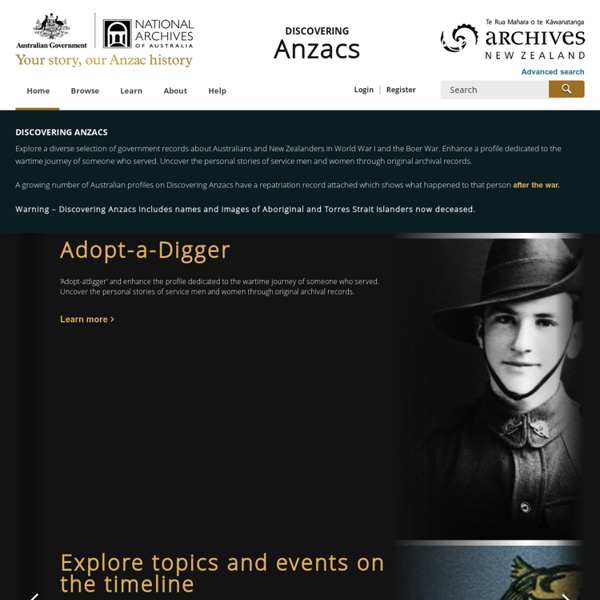



First World War 1914–18 Australian troops in the Lone Pine trenches. A02022 A02022 Australian troops in the Lone Pine trenches. AWM A02022 Australia’s involvement in the First World War began when Britain and Germany went to war on 4 August 1914, and both Prime Minister Joseph Cook and Opposition Leader Andrew Fisher, who were in the midst of an election campaign, pledged full support for Britain. The outbreak of war was greeted in Australia, as in many other places, with great enthusiasm. The first significant Australian action of the war was the Australian Naval and Military Expeditionary Force’s (ANMEF) landing on Rabaul on 11 September 1914. On 25 April 1915 members of the Australian Imperial Force (AIF) landed on Gallipoli in Turkey with troops from New Zealand, Britain, and France. Throughout 1916 and 1917 losses on the Western Front were heavy and gains were small. For Australia, the First World War remains the costliest conflict in terms of deaths and casualties. Sources and further reading: C.E.W. J.
Home | Australian War Memorial Service records Discovering Anzacs – The National Archives of Australia and Archives New Zealand commemorate the Centenary of Anzac. The National Archives holds records about service in the Australian defence forces from Federation in 1901. Find out how to access the records we hold relating to service with the: Australian Army (Army) Royal Australian Navy (RAN) Royal Australian Air Force (RAAF) We also hold other records relating to wartime service, including: civilian servicecourts-martial filesmerchant navymunitions workerssoldier settlementveterans’ case fileswar gratuities Under the Archives Act, you have a right of access to Commonwealth government records that are in the open access period. For wider research, you may also want to consult the Archives records about defence administration and policy or unit, operational and administrative records held by the Australian War Memorial. See also the list of abbreviations used in some service records.
Gallipoli 2015 home page Digitised WWI Victorian newspapers | State Library Victoria A major project commemorating World War I has digitised 216 WWI-era Victorian community newspapers and made them available online via the National Library of Australia’s Trove portal. Victorians everywhere can now explore the stories of their communities and family and friends who lived and fought through the Great War. This digitised collection contains thousands of stories waiting to be found. These newspapers of the day provide, in their original format, news and public debate; letters from soldiers, sailors and nurses; death notices, images and more. The newspapers can be freely and easily searched by anyone at anytime and anywhere, using keywords, dates or geographical regions. The digitised newspapers cover the period 1914–19. The digitisation of these newspapers has been supported by the State Library of Victoria, National Library of Australia, Public Libraries Victoria Network, local councils and historical societies.
Australian pictures in Trove Picture Australia has been absorbed into Trove. It was originally launched in September 2000, and at that time, was a unique and ground breaking service, bringing together digitised images from cultural heritage collections around Australia for not only all Australians to see but also the world. Contemporary images were sourced from Flickr via a series of Groups, which ensured individual contributions to Picture Australia were included in the snapshot of Australiana. We will continue with this tradition using the Trove: Australia in Pictures Group. To read more about how we integrated Picture Australia into Trove please see the bulletins in the Trove forum. Please be aware that as a result of this integration the format of search URLs have changed, therefore any saved or bookmarked Picture Australia hyperlinks that use search terms will no longer work. You may want to learn how to construct Trove search URLs to replace any Picture Australia links you have.
Home - Anzac Centenary Victorian Government Trove - Pictures, photos, objects Search photographs, negatives, artworks, drawings, posters, postcards and other pictures, as well as physical objects such as puzzles, instruments and clothing. Contribute your photos to Trove! Find out how to do it. 1,256 photos have been contributed to Trove via Flickr this month. Trove's Pictures, photos, objects zone owes much of its existence to one of the National Library's first discovery services, Picture Australia. Picture Australia was originally launched in September 2000 and, at that time, was a unique and ground breaking service, bringing together digitised images from cultural heritage collections around Australia for not only all Australians to see but also the world. It began with less than half a million images from seven institutions and, over the years, grew to two million images and more than 70 contributors. Picture Australia has been absorbed into Trove.
Anzac Centenary - home Essendon Historical Society Australians on the Western Front 1914-1918